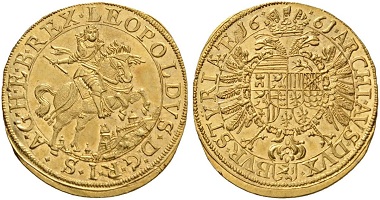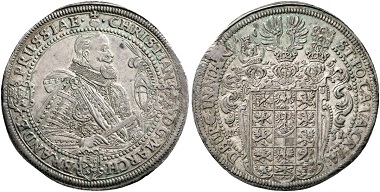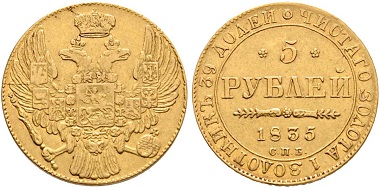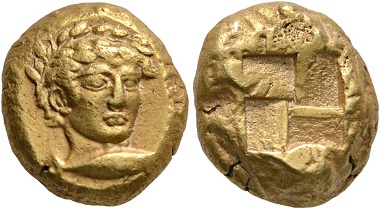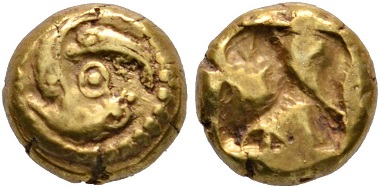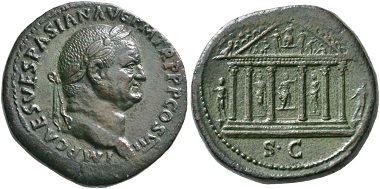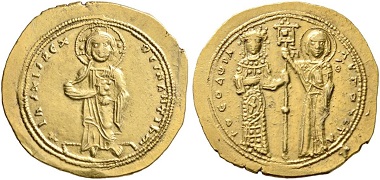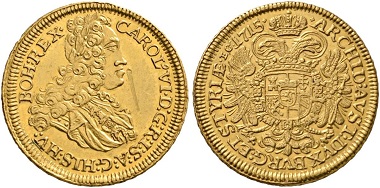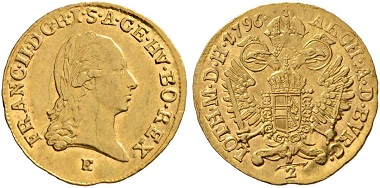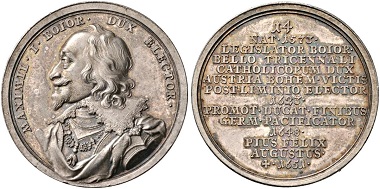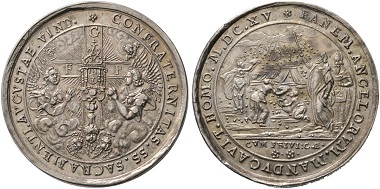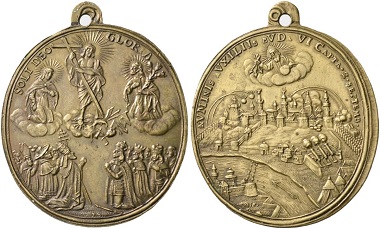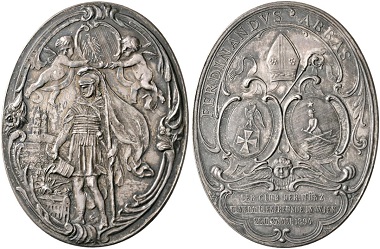22-05-2017 – 01-01-1970
Auction 164: Numismatic Rarities
Find a Competition to Mark the Jubilee of 70 Years of Lanz Graz in the latest auction catalogue of Numismatik Lanz 164!
For 70 years, Numismatik Lanz has been a synonym for coin purchase free from worry. Whether from stock, at auction or online, the name Lanz is a guarantee that the coins have been carefully described and examined for their authenticity. To illustrate to his customers how important a professional coin trade is for a quality-conscious customer, Dr. Hubert Lanz has come up with something very special on the occasion of his company’s 70th anniversary. The current auction catalog contains a fake. Collectors who discover this fake will benefit from a 25 euro credit note given they have a winning bid in the auction. If you think you have found the faked coin, write an email, stating the relevant number and your address. The winners will be informed directly by Lanz.
Of course, you don’t have to be afraid of accidentally buying the fake coin. Bids for it won’t be accepted; bidders will be advised directly. Besides, one week prior to the auction, Lanz will reveal the identity of the relevant coin. And one more thing: Obviously, we won’t include the piece in this auction preview.
362. Holy Roman Empire. Leopold I, 1657-1705. Ducat 1661, Graz, on the city fortification. The emperor on horseback, in the right lower corner of the background Schlossberg with clock tower, bell tower and casemates as well as city scape with Cathedral and step church. 4th known specimen, only two specimens in private possession. FDC. Estimate: 35,000 euros. Starting price: 21,000 euros.
At the customer’s service for 70 years: the numismatic dealership Numismatik Lanz
On April 1, 1947 Dr Hermann Lanz (1910-1998) founded the numismatic dealership Numismatik Lanz in Graz. At that time, he had quite a good reason for it. To the holder of the chair for Internal Combustion Engines at the Graz University of Technology, his love for gliding had turned out to be his undoing. While the Allied occupation had forbidden any flight and aviation activity in Austria, he had worked towards a new beginning of his University gliding sports group “Akaflieg”. When this came out, the professor was stripped of the chair in 1947.
433. Brandenburg-Bayreuth. Christian (1603-1655). Taler 1631, Nuremberg. Very rare. This year unedited. From the E. von Waldenfels Collection. Extremely fine. Estimate: 10,000 euros. Starting price: 6,000 euros.
Although Hermann Lanz became a co-founder of a new “Akaflieg” in 1953 after all and although he was given a complete academic rehabilitation in 1957, the Münzhandlung Graz had evolved into a world-famous player in the international coin market by then. That is why Hermann Lanz was also involved in the founding of the International Association of Professional Numismatists. Today, the grand seigneur with his impressive beard is ranked among the most distinguished European numismatists of the post-war era.
472. Russia. Nicholas I (1825-1855). 5 rubels 1835, St. Petersburg. Extremely rare. Very fine. Estimate: 20,000 euros. Starting price: 12,000 euros.
Coin trade in the 2nd generation
In 1963 and 1966, the two sons Ernst (1945-1989) and Dr. Hubert Lanz (*1943), respectively, became part of the business. In 1972, Numismatik Lanz conducted its first auction, still in Graz, before headquarters were moved to Munich after the auction house of Gitta Kastner had been acquired in the aftermath of her unexpected death in 1977. 164 auctions – including 15 that took place in Graz – have been held ever-since. World-famous collections were sold at Lanz, for instance the ones of Marquis de Hohenkubin, of fashion queen Margaretha Ley (Escada), the Roman coins of Leo Benz or Corinth and Euboea from the BCD Collection.
Since 1999, Numismatik Lanz not only has two real numismatic dealerships located in Graz and Munich but a virtual one on eBay, too. It has become a major contact point for coin collectors throughout the world. In April 2016, Numismatik Lanz was happy to celebrate its 200,000th invoice for an item sold at eBay.
475. Transylvania. Achatius Barcsai (1659-1660). Ducat 1660, Hermannstadt (Sibiu), minted during the occupation by George Rákoczi. Extremely rare. Very fine. Estimate: 20,000 euros. Starting price: 12,000 euros.
Champion for the rights of collectors and a high-quality coin trade
For decades, the current owner of Numismatik Lanz, Dr. Hubert Lanz, has been campaigning for the right of coin collectors. He did so very successfully as President of the Association of German Coin Traders and as Chairman of the Federation of the European Numismatic Trade Associations.
54. Cyzicus (Mysia). Electrum stater, 500-450. Rare. Almost extremely fine. Estimate: 15,000 euros. Starting price: 9,000 euros.
Auction 164
On May 23, 2017 Numismatik Lanz will conduct Auction 164 in their business premises, offering numismatic rarities from antiquity as well as from medieval and modern times.
76. Phocaea (Ionia). Electrum hekte, 520-500. Rare. Very fine. Estimate: 1,500 euros. Starting price: 900 euros.
Celts – Greeks – Romans – Byzantines
5 Celtic, 100 Greek, 188 Roman, and 42 Byzantine coins will come under the hammer. There will be something available to everybody’s liking. Whether rarities in the department of fractions or rare strikings in an exceptional grade, all items have a collector-friendly estimate.
Everybody interested in coins made of electrum should study the catalog with care. He or she will discover interesting strikings from Mytilene and Phocaea as well as from Cyzicus, not to mention early strikings coming from Lydia.
155. Vespasian, 69-79. Sestertius, 76. Rv. Temple of Jupiter Capitolinus. From Niggeler Collection (1967), No. 1161. Rare. Extremely fine / almost extremely fine. Estimate: 4,500 euros. Starting price: 2,700 euros.
Among the Roman Republican coins, the time of the imperators is particularly well-represented. Cases in point are rare denarii of C. Cassius and Lentulus Spinter, of Brutus and Octavian.
Roman Imperial times are also worth a second look. There is much to be discovered. We only need to think of aurei with collector-friendly appraisals, perfectly preserved denarii of emperors as much sought-after as Hadrian or an entire series of bronze coins with depictions rich in figural representations and steeped in history. Needless to add, that the coins also of the rare emperors will be available for sale as well. The catalog lists five different lots of Pertinax alone.
317. Theodora, 1055-1056. Histamenon. Extremely fine. Estimate: 3,000 euros. Starting price: 1,800 euros.
The small series of Byzantine coins, which entails such rarities as a histamenon of Empress Theodora, will be concluded by a selection of Byzantine lead seals.
348. Carolingians. Charlemagne (768-814). Denar, Soisson. Extremely rare. Extremely fine. Estimate: 6,000 euros. Starting price: 3.600 euros.
Migration Period and early Middle Ages
From the Poncin Collection comes a solidus of Ostrogoth King Odoacer, issued in the name of Zeno. Slightly filed on the rim but otherwise extremely fine, the extremely rare piece has been estimated at 5,000 euros.
The unchallenged highlight of the Carolingians coins is a denar of the utmost rarity from Soisson. Minted on behest of Charlemagne after his accession to the throne, this is one of the early coins produced prior to his comprehensive 793 monetary reform. The legend being clearly struck, the coin can be safely attributed to the Soisson Mint. This explains the coin’s great historical importance.
365. Holy Roman Empire. Charles VI (1711-1740). Triple ducat 1715, Graz. From Lanz sale 83, 194. Unique. Inspection mark, otherwise almost FDC. Estimate: 30,000 euros. Starting price: 18,000 euros.
The House of Habsburg
The great rarities can be found among the strikings of the House of Habsburg. Here, the undisputed highlight is a 1661 ducat. Featuring Leopold I on horseback in front of the Graz Schlossberg with clock tower, bell tower and casemates, this constitutes the fourth known specimen two of which are housed in the Vienna Coin Cabinet and the Graz Joanneum.
From the same emperor comes an extremely rare double ducat, minted in Graz in 1687, in the most magnificent grade imaginable. Also from Graz comes a triple ducat from 1715 with the portrait of Charles VI. Apart from a slight inspection mark in the field on the obverse, the unique striking is in a marvelous grade.
370. Holy Roman Empire. Francis I (1745-1765). 1/2 ducat 1796, Karlsburg. From Lanz sale 110, 244. Extremely fine. Estimate: 6,000 euros. Starting price: 3,600 euros.
Let us conclude this survey of Habsburg rarities with a 1732 coin of 2 ducats that was struck to commemorate the homage of the Upper Austrian estates to Charles VI, and with a 1/2 ducat from Karlsburg from 1796 of which only one other example is known.
393. Bavaria. Maximilian I (1597-1623-1651). Suite medal no date (1766/7-1770) by Franz A. Schega. Rare. FDC. Estimate: 600 euros. Starting price: 360 euros.
Germany und foreign countries
Of course, interesting strikings can be discovered among the coins and medals from the German states and foreign countries as well. Everybody interested in Bavaria is familiar with die cutter Franz Andreas Schega (1711-1787), first Bavarian court medalist since 1751. He designed a large medal suite of the Bavarian dukes and electors, chronologically ranging from Otto III of Wittelsbach (1180-1183) to Maximilian III (1745-1777). At Lanz, the silver medals with the outstanding portraits can be bought individually, just as the pieces from the medal suites with Papal portraits by Georg Wilhelm Vestner (in bronze) and P. H. Müller (in silver).
447. Augsburg. Medal 1615 by Christian Maler on the Brotherhood of the Most Holy Altar Sacrament in the Holy Cross Church. Probably unique. FDC. Estimate: 10,000 euros. Starting price: 6,000 euros.
The Rudolf von Höfken Collection of Pilgrim Badges and religious medals
The auction sale will be concluded by the Rudolf von Höfken Collection. It comprises of pilgrim badges and medals, most of these coming from Austrian churches and monasteries. Some medals of this important collection formed part of the Germany section.
549. Budapest. On the victory of the Imperial troops over the Turks. Brass medal 1686. Very rare. FDC. Estimate: 600 euros. Starting price 360 euros.
Whether for 10,000 or 300 euros, all strikings are of the utmost interest because of their historico-cultural significance. As an example, let’s take a 1686 brass medal on the victory of the Imperial troops over the Turks. The obverse features the leader of the Imperial estates, which had provided the troops for this war, praying to victorious Jesus Christ whom Mary and Joseph ask for help for oppressed Christianity. The reverse shows the city of Ofen (Buda) which had been re-gained for Christianity on September 2, 1686 after 145 years of Turkish rule.
591. St. Florian. On the visit of the “Club der Wiener Münzen- und Medaillenfreunde”. Silver medal 1894. Very rare. FDC. Estimate: 500 euros. Starting price: 300 euros.
A testimony to a completely different kind of pilgrimage stems from 1894 and recalls a trip of the “Club der Wiener Münzen- und Medaillenfreunde” to St. Florian where the numismatic club members visited the monastery provost, Ferdinand Moser. In his days, this clergyman was an important politician who represented the Conservatives in the Imperial Council, and harbored an interest in geography and history. Most likely having called a coin collection his own, he was in contact with the members of the Vienna-based coin club.
Please remember! Only a customer attending the Numismatik Lanz Auction directly – sending a bid by letter or phone, over the internet or participating in person – is entitled to the preferential starting price of 60%! Please make sure to plan ahead: The auction sale catalog can be viewed online. You may as well request a printed copy for a nominal charge of 15 euros at Numismatik Lanz, Maximiliansplatz 10, D-80333 Munich, email, phone: +49 / 89 / 29 90 70, fax: +49 / 89 / 22 07 62




